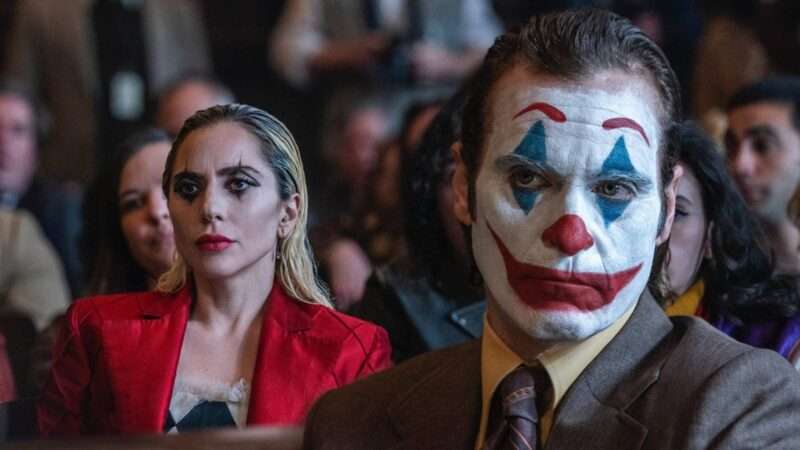
Sometime over the past several years, a particular meme-like social media post format became popular: Someone would post someone saying something that was totally self-contradictory or self-undermining, something so patently crazy or ridiculous that no sane and reasonable person could possibly accept it.
Given the timing, this was probably at least partially the result of the 2019 movie Joker, an origin story in which Batman's archnemesis was portrayed as a dim, desperate, depressed loser who snaps in response to an uncaring, ugly world that seems formless and out of control.
Well, I'm here to tell you that I have seen the follow-up, Joker: Folie à Deux, and that it is such an inert, joyless, unpleasant slog, I struggle to conceive of how it got made or to plausibly imagine what any sane person could have been thinking during the development or production.
Joker: Folie à Deux is a two-hour-plus, event-free recapitulation of the events of the previous film. Nothing happens. The first Joker was ugly in spirit and had essentially one thematic note, but there was at least a steady progression toward a moment when the titular character would finally manifest in full. The sequel has no such progression, and indeed very little narrative at all. It's mostly just a recap of the first film, plus some underwhelming musical numbers in a courtroom setting. It's lifeless, pointless, and humorless throughout.
How, again, did this movie get made? Just—how?
Dear readers: I am going to become the Joker.
The obvious answer to that question, unfortunately, is probably that the first Joker made $1 billion worldwide at the box office and also generated some Oscar noms, a rare feat for a grimy R-rated comic-book film. This necessitated a sequel, and also gave director and co-writer Todd Phillips more control.
And what Phillips seems to have wanted, more than anything else, was to make a feature-length rebuke to fans of the first film, especially fans who thought Arthur Fleck—the sad, disturbed, lonely man who becomes a famous murder clown—was kind of cool.
The first film was about this too, in a way casting the Joker's rise as a cautionary tale about the viral allure of crazy people committing sensationalistic acts while being egged on by the media. It wasn't a good movie, but Joaquin Phoenix's gaunt, menacing portrayal of the title character was charged with anarchic energy, and its Martin Scorsese-inspired portrayal of Gotham by way of New York around 1980 made a great backdrop for its tale of a desperate clown going murderously mad.
For the follow-up, Phillips has chosen to return to the events of the first film, reviewing them in conversations between Fleck and his lawyer in a sensationalistic TV interview, and finally in a trial that takes up much of the movie's second half. At every point that Phillips could have moved the story forward, or allowed something to happen, he slams on the brakes and demands instead that the movie gaze backward. It's an extended sneer of a film that spends most of its time not only recapitulating all the ways that its main character is and was awful, but insisting that if you enjoyed the first movie as a fan, you probably are too.
To this dull setup, Phillips adds two new, related elements. First, there is Lady Gaga as Joker's crazy flame, Harley Quinn. Second, and presumably because of the first, the sequel is a musical of sorts with a handful of set-piece singing numbers that showcase Fleck's deteriorating mental state. Gaga's job is to sing and look the part, and she does both reasonably well. Yet, outside of a pyromaniac meet-cute with Mr J., the movie gives her very little to do.
Still, she's the only character with anything like an arc or a transformation: At the end, she becomes Harley Quinn, Joker's tormented sidekick and lover. Yet her climactic moment comes when she finally shows up in clown makeup and costume, as a camera-ready reflection of her superfan obsession: In that moment, she becomes the Joker too.
Quinn was introduced three decades ago in Batman: The Animated Series, an animated children's show that also offered surprisingly sophisticated takes on the caped crusader and his weirdo rogue's gallery. It located the rude and rowdy characters of the Joker and Harley Quinn not in their tortured biographies or their cracked psychologies, but in their zany, warped, comically violent actions and interactions with each other.
In retrospect, it serves as a counterpoint to Phillips' glumly, literal mytho-psychologizing. The show's leering, menacing, playfully psychopathic Joker, voiced with maniac glee by Mark Hamill, was fully realized rather than fully explained. The crazy didn't get to him. He was the crazy that got to everyone else.
To put it another way: He didn't become the Joker—he just was the Joker.
It's a far more frightening way to explain the persistence of madness in the world, the terror of the violent unknown. And in its implied reversal of the meme, it suggests a worrying possibility: Maybe instead of suddenly cracking at the craziness of an insane world, we've all always been the Joker all along.
The post <i>Joker: Folie à Deux</i> Is a Miserable Musical Slog appeared first on Reason.com.







